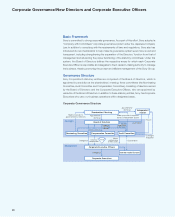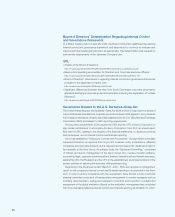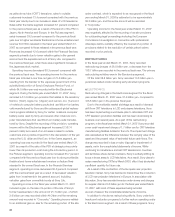Sony 2007 Annual Report Download - page 61
Download and view the complete annual report
Please find page 61 of the 2007 Sony annual report below. You can navigate through the pages in the report by either clicking on the pages listed below, or by using the keyword search tool below to find specific information within the annual report.58
TREND INFORMATION
This section contains forward-looking statements about the
possible future performance of Sony and should be read in light
of the cautionary statement on that subject, which appears on
the inside back cover and applies to this entire document.
ISSUES FACING SONY AND MANAGEMENT’S RESPONSE
TO THOSE ISSUES
Competition in many of Sony’s business segments continues to
intensify and price erosion, especially in the Electronics segment,
remains persistent. Competition has intensified due to the
penetration of broadband, which has led to an augmentation of
network infrastructure, making it easier for companies in other
sectors to enter the markets in which Sony competes.
In response to these challenges, Sony has been undertaking
initiatives to improve its competitiveness and strengthen the
quality of its management, such as a reduction in the number of
business categories and the number of models, a rationalization
of manufacturing sites and the creation of a more efficient
administrative structure, as well as the sale of non-core assets
(refer to “Restructuring” in “Operating Results” for more detailed
information about restructuring). This plan, developed in consul-
tation with Sony’s stakeholders both inside and outside the
company, moved to strengthen Sony’s competitiveness in three
core sectors—Electronics, Game and Entertainment—through
a balanced mix of restructuring and growth initiatives combined
with a new organizational structure. In particular, it is the revitaliza-
tion of Electronics that management regards as the most pressing
issue confronting Sony today. As well as reorganizing its Electronics
business to place centralized decision-making authority over key
areas under the Electronics CEO, Sony is implementing reorga-
nization initiatives to strengthen horizontal coordination in the
key areas of product planning, technology, procurement,
manufacturing, and sales and marketing. For Sony’s growth
strategy in Electronics, resources will be focused on the devel-
opment and commercialization of high-definition products,
mobile products and advanced semiconductors and other key
devices that can further differentiate these products, targeting
enhanced competitiveness and improved profitability. In the
Game segment, Sony intends to expand the PLAYSTATION®3
(“PS3”) platform while developing its PlayStation®2 (“PS2”) and
PSP® (PlayStation®Portable) (“PSP”) businesses.
In addition to this cost-cutting and investment for growth, each
of Sony’s business segments grappled with issues specific to that
segment. Below is a description of the issues management
believes each segment continues to face and an explanation as to
how each segment is approaching those issues.
■ELECTRONICS
Although the Electronics segment continues to hold a very
strong position in the worldwide consumer audio visual products
market, that position has become increasingly threatened as a
result of the entrance of new manufacturers and distributors.
These new entrants are threatening Sony’s position due to the
industry shift from analog to digital technology. In the analog era,
complicated functionality of electronics products was made
possible through the combination of several complex parts, and
Sony held a competitive advantage in the design and manufac-
ture of those parts as a result of its accumulated expertise. In
the digital era, however, complicated functionality has become
concentrated on semiconductors and other key digital devices.
Since these semiconductors and key devices are able to be
mass produced, they have become readily available to new
market entrants, and the functionality that once commanded a
high premium has become more affordable. This has led to
intense price erosion in the consumer audio visual products
market. To respond to these challenges, Sony is striving to keep
pace with price erosion by reducing its manufacturing and other
costs. It is seeking to maintain the premium pricing it enjoys on
many of its end-user products by adding functionality to those
products and developing new applications and ways of use that
appeal to the consumer. In addition, it is taking steps to increase
its competitive edge by developing high-value-added semicon-
ductors and other digital key devices in-house. By enhancing
the in-house production of key devices, Sony aims to incorporate
added-value into these key devices.
In the area of semiconductors, in the fiscal years ended
March 31, 2006 and 2007, Sony carried out 140 billion yen and
150 billion yen, respectively, of capital expenditures mainly on
system large scale integrations (“LSI”) and charged coupled
devices (“CCDs”). These totals also include Sony’s investment in
semiconductor fabrication equipment built at the 65 nanometer
process technology level. Chips that will be manufactured using
this equipment will be some of the most highly advanced on the
market, and will include system LSI, in particular the Cell Broad-
band Engine™ (“Cell/B.E.”) microprocessor for the broadband
era, which is already used in the computer entertainment
system, PS3, and is anticipated for use in digital consumer
electronics products. Over the last five years, Sony Corporation,
Sony Computer Entertainment Inc. (“SCE”), IBM Corporation
(“IBM”) and Toshiba Corporation (“Toshiba”) have carried out
Operating and Financial Review
Sony Corporation and Consolidated Subsidiaries
























